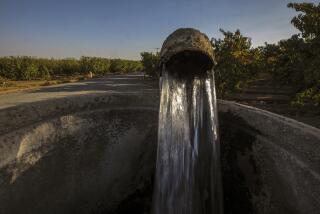Op-Ed: Water for farms — and fish and fowl
In an absurd twist, the villain of the California drought — once the almond farmer — is now the natural world, with some water districts and politicians regularly claiming that we set aside too much water for environmental purposes. Last week, the House passed and moved to the Senate a bill that would divert water from Central Valley wildlife refuges, undermine the Endangered Species Act and reverse the restoration of the San Joaquin River.
Characterizing the environment as an “interested party,” similar to agriculture — as some officials have — is a distortion. But if we go along with this characterization and try to say with a straight face that migratory birds are “users” and endangered fish are “stakeholders,” then it would be fair to conclude that the environment has given more than its share.
John Muir walked through the San Joaquin Valley in 1868 and described it as “the floweriest piece of world I ever walked, one vast level, even flower bed ... a smooth sea, ruffled a little in the middle by the tree fringing of the river and of smaller cross-streams here and there.”
At that time, the meandering Sacramento and San Joaquin rivers and their tributaries created extensive river habitats and wetlands that supported large numbers of migratory birds, wild salmon and large mammals.
Then we divided the forests, drained the wetlands and dammed the rivers to build farms and cities. In the 1930s, California built the Central Valley Project and the State Water Project to pump water into these expanding agricultural and urban areas.
Soon more than 90% of the valley’s wetland habitat was gone, leaving just a patchwork of refuges. Waterfowl populations dropped from historic levels as high as 40 million to as low as 5 million today.
Recognizing this environmental deterioration, Congress in 1992 set minimum water allocations so the refuges could meet basic wildlife needs. A lawsuit and 2006 settlement agreement compelled state and federal government to restore the San Joaquin River.
The refuges, however, have not once received their congressionally mandated amount of water, even in wet years. Last year, the refuges’ combined allotment was only about 11% of the Central Valley Project’s total deliveries. That amounted, on average, to 57% of what biologists say is the bare minimum to support birds and other wildlife. Refuges in the hardest-hit drought areas got far less; the Kern National Wildlife Refuge received only 30%. This year’s allocations could be so low that managers might consider closing some sites to all recreational use.
Conservation advocates are sympathetic to the challenges that communities and farmers are facing, and understand that there will be cutbacks in water for the environment. Major laws governing environmental allocations, including the Central Valley Project Improvement Act and the San Joaquin River Restoration Act, already contain stipulations that either reduce water deliveries or halt them altogether during drought. Yet some lawmakers continue to call for the environment to give more.
That’s the wrong approach. Even if every drop of water going to the refuges could be diverted to other uses, it wouldn’t come close to alleviating the drought.
Local, state and federal agencies have invested in refuges for decades to protect their value for birds, other animals and nearby communities. Destroying them would only endanger California’s already fragile wildlife and degrade the other services refuges provide, such as groundwater recharge, water quality improvements and recreation.
Instead of pitting the environment against farms and communities, let’s invest in infrastructure projects that improve water delivery for all. The Modesto City Council just took a step in this direction by approving the North Valley Regional Recycled Water Program, which will create “new” water for both farms and refuges. Conservation creates permanent increases in supply, so investment in those programs makes much more sense than one-time transfers.
If we do give farmers priority at the environment’s expense, then we should at least mitigate losses to our Central Valley landscapes. For example, if ducks rely on a farm as a surrogate wetland habitat, and that farmer decides to sell his water allotment and let the field go fallow, a small portion of that transaction could pay for water on a nearby refuge.
The drought is a crisis for everyone. It’s not an opportunity for those who are philosophically opposed to environmental protections to settle old scores.
Brigid McCormack is executive director of Audubon California.
Follow the Opinion section on Twitter @latimesopinion and Facebook
More to Read
A cure for the common opinion
Get thought-provoking perspectives with our weekly newsletter.
You may occasionally receive promotional content from the Los Angeles Times.






